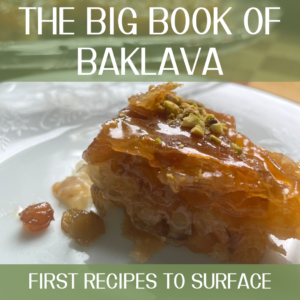
For the longest time, I was told that baklava was nothing like it is now. Even the description, by a 14th Century Sufi poet named Kaygusuz Abdal from Qaraman, that mentioned hundreds of trays of baklava made of almonds and lentils, of all things, was believed to just be a satirical comment on the excesses of serving such an expensive food, much like the Roman “Trimalchio’s Banquet” in Petronius’ Satyricon (75 AD). From 2006 to 2015, I continued to go about my business of baklava, using what I believed to be as close a recipe as possible.
And then the revelation of a set of 16th/17th Century recipes. brought to light by Mary Işin, found in an unnamed manuscript and presented during a culinary symposium in Turkey in the 1980s by Fuad Bayramoglu. These unappreciated recipes illuminated a long, dark corner of food history. The set of recipes from this unnamed medical treatise gave not only extensive and elaborate descriptions of how to construct baklava, but also how to make the very dough of its foundation. called yufka. I began to experiment with different variations on that dough. and endeavored to learn the art of rolling yufka. The word yufka is interchangeable with phyllo, raqaq. and lavash (these are all various names for thin bread). and has been used for many centuries. dating back to its Mongolian/Turkic roots.

The first chef to instruct me on how to roll yufka in person was Nadiye Akgun, chef at Sofra restaurant in Bloomington. Indiana. I was there on a work trip and went for dinner one evening at her Turkish restaurant. I looked at the cold case and saw that she was serving hand-rolled Borek and baklava. So I ate dinner and came back again the next day for lunch, and then dinner, and began to engage in a conversation with her about my passion for understanding the food of her homeland.
I quietly and carefully inquired as to whether or not she ever did cooking classes, and she said she really didn’t have time or room for that—and she asked me why. I told her my goal was to learn how to roll yufka, to which she responded with delight, “I would be happy to show you!” She took me under her wing, brought me into her kitchen, and showed me the technique which I then took home and began practicing myself, first by making my own oklava (the thin rolling pin used to roll yufka). I found myself trying to find YouTube videos on how to make this elusive dish and try to learn all that I could.
In the video above, I’m rolling yufka for “Baklava ve Qaraman,” the earliest recipe for baklava that we have.